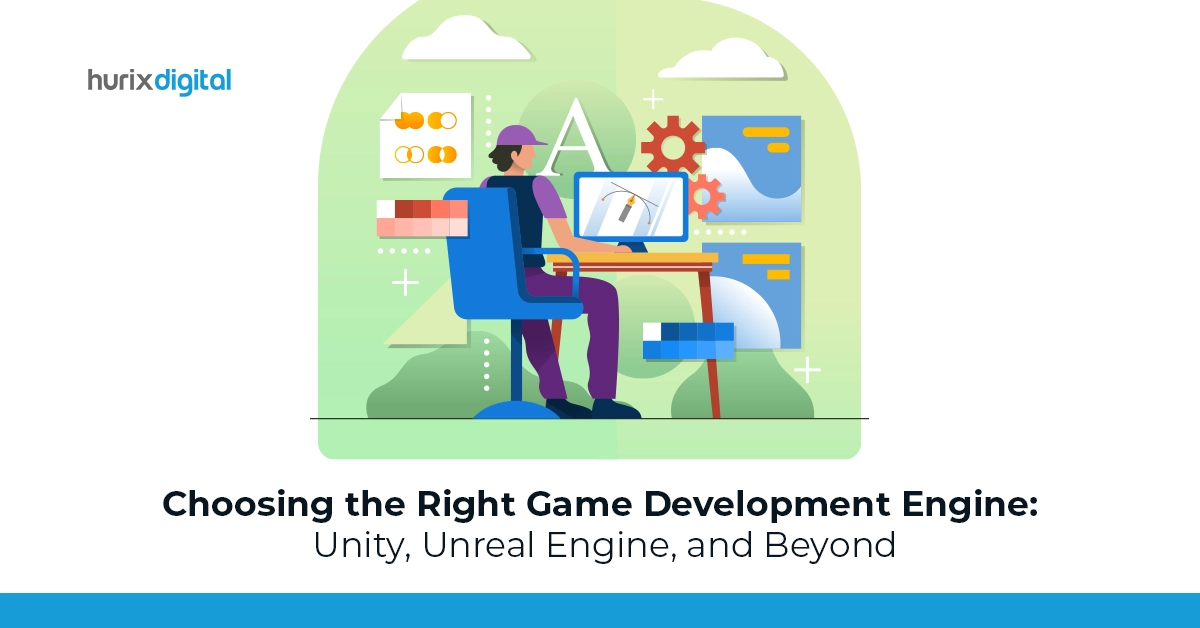
Choosing the Right Game Development Engine: Unity, Unreal Engine, and Beyond
Summary
Explore the key considerations for selecting a game development engine. This article compares Unity, Unreal Engine, and other options for effective game creation.
Imagine a digital workbench equipped with everything you need to create interactive worlds. That is essentially a game app development engine, a software framework that simplifies game development by consolidating crucial elements like graphics rendering, physics, sound, and AI.
The booming game app development industry owes much to powerful engines like Unity and Unreal. These user-friendly game development tools empower indie developers and AAA studios to create immersive worlds. But with both their popularity, picking the right one can be tricky.
This article explores the features of Unity, Unreal, and other popular game engines, helping you make an informed decision. Stay tuned as we delve into their graphical capabilities, coding requirements, ease of use, and target audiences.
Table of Contents:
- Game App Development Engines Explained
- What is Unity?
- What is Unreal?
- Game App Development Showdown: Unity and Unreal
- Unity or Unreal?
- Other Popular Game Development Engines
- The Bottom Line
Game App Development Engines Explained
Popular engines like Unreal and Unity allow developers, from solo creators to large studios, to build immersive games for various platforms (PC, console, and mobile). While Unity and Unreal might seem similar at first glance, subtle distinctions exist. Understanding these nuances is crucial for selecting the right engine to bring your game app development vision to life.
Also Read: AEM Development Services: How to Choose the Right Provider for Your Project?
What is Unity?
Unity, born from the minds at Unity Technologies, at Apple’s 2005 WDC, is a cross-platform game engine empowering creators to bring their interactive visions to life. Spanning 2D, 3D, and VR experiences, it caters to seasoned professionals and aspiring developers alike. Its prowess lies in its extensive platform support, encompassing PCs, consoles, mobile devices, and even VR headsets. This flexibility allows developers to reach a vast audience, regardless of their target platform.
Unity leverages C#, a widely recognized and powerful language for game app development. Beyond its core purpose, Unity has surpassed the realm of gaming, finding applications in film animation systems, visual effects, and even industries like automotive and architecture.
What is Unreal?
Since its debut in 1998, the brainchild of Tim Sweeney, Unreal Engine has established itself as a dominant force in the realm of 3D graphics and game app development. Initially showcased through the acclaimed first-person shooter “Unreal,” it has evolved into one of the leading game development tools, empowering developers to craft not just games but also physics simulation, animation, and immersive virtual experiences.
Unreal boasts impressive portability, seamlessly adapting to various platforms, from PCs (Windows, Mac, Linux) and consoles (PlayStation, Xbox, Switch) to mobile devices (iOS, Android). But Unreal’s true strength lies in its ability to render cutting-edge visuals and next-generation physics simulation effects.
This commitment to visual fidelity has earned it a reputation as an industry standard, attracting awards and gracing some of the world’s most popular games, like Fortnite, Gears 5, and Quantum Error.
Game App Development Showdown: Unity and Unreal
It’s time to put Unreal and Unity head-to-head. Here we explore a comparative analysis of Unreal and Unity.
1. Coding
The first key distinction between Unity and Unreal lies in their chosen languages. Unity utilizes C# throughout its editor and plugins, offering a familiar and widely adopted syntax.
In contrast, Unreal utilizes a blend of C++ and its proprietary Blueprint scripting language. While C++ offers granular control and raw performance, Blueprint provides a visual scripting system, making it accessible even for those without extensive coding experience.
2. Graphics
Initially, Unity’s strength lay in clear documentation and ease of use for programmers, while Unreal boasted superior default visuals. It led to the perception of Unity favoring coders and Unreal catering to artists. Unity’s HDRP pipeline addresses its previous graphical limitations, while Unreal’s documentation has become more comprehensive.
Both now offer visual scripting tools for artists without extensive coding experience. While Unreal still holds an edge in features like volumetric fog and post-processing, Unity, aware of the gap, is committed to significant graphical improvements in future versions.
3. Learning Curves
Unity’s streamlined interface and extensive support resources make it an ideal choice for newcomers. Unreal’s deeper feature set caters to experienced developers willing to invest time in mastering its complexities.
- Accessibility: Unity has long been admired for its user-friendly interface, attracting new developers with its intuitive layout and streamlined workflows. Recognizing this strength, Unreal Engine has made strides in improving its usability with recent updates. However, it still leans towards a slightly more complex structure than Unity.
- Interface Similarities: Despite their differences in complexity, both engines share some design elements. It offers a degree of familiarity to anyone transitioning between them.
- Performance Trade-Offs: While Unreal boasts an extensive feature set, it comes at the cost of heavier resource utilization. Load times and asset import/export processes tend to be slower in Unreal compared to Unity’s more optimized interface.
- Visual Fidelity vs. Development Ease: While games developed with Unreal can potentially achieve a more professional and detailed aesthetic, this advantage comes at the cost of increased effort and complexity. It often makes Unreal less suitable for beginners than Unity’s gentler learning curve.
- Community Support: Unity has always maintained robust and readily accessible documentation. Its Reddit community boasts nearly double the size of Unreal’s, providing a broader knowledge base and more active conversations to support developers facing challenges.
4. Target Audience
Initially, Unity’s user-friendly design made it a popular choice among indie developers, while Unreal’s power catered mainly to AAA studios. However, recent developments are blurring these lines.
Unreal’s strategic pricing adjustments and a thriving asset marketplace featuring free resources like the Paragon asset library entice the indie community for prototyping and asset acquisition.
While Unreal maintains its foothold among AAA companies, its enhanced scalability is attracting smaller publishers. Its ability to handle vast worlds and complex systems gives it an edge over Unity in demanding projects.
Unity or Unreal?
Choosing the right game app development engine can feel like navigating a competitive race, and the Unity vs. Unreal debate is no exception. While a definitive answer does not exist, understanding their strengths and weaknesses can guide your decision.
Unity
- Strengths: beginner-friendly, large user base, robust 2D/3D support, C# coding.
- Weaknesses: lower graphical fidelity, and limited scalability for AAA projects.
Unreal
- Strengths: high-fidelity graphics rendering, powerful and scalable, vast asset management library.
- Weaknesses: steep learning curve; C++ coding (may deter beginners).
Ultimately, the best choice depends on:
- Project requirements: Consider the scale, complexity, and desired visual game style.
- Coding experience: Unity’s C# might be more approachable for newbies.
- Budget: Unity’s free-tier and royalty-free model appeal to budget-conscious projects.
Both engines offer free versions, allowing you to experiment and find the perfect fit for your game app development journey.
Other Popular Game Development Engines
While Unreal and Unity dominate the game app development sphere, several other game engines have garnered significant popularity among developers.
Amazon Lumberyard
Amazon Lumberyard, a free, cross-platform game engine built upon CryEngine, offers a robust solution for AAA studios and indies. Recently open-sourced, Lumberyard provides a modular approach to game development with Open3D.
Strengths
- Cost-Effective Development: Free for single-player games, Lumberyard caters to various budgets.
- Advanced VR Support: Integration with Amazon Web Services (AWS) allows developers to create immersive VR experiences.
- Seamless Online Play: Native support for features like C++, P2P, and client topology simplifies online multiplayer development.
Weaknesses
- Project Size Suitability: Lumberyard’s feature set may be overwhelming for smaller development projects.
- Resource and Material Limitations: Compared to some competitors, Lumberyard’s asset library may be less extensive.
CryEngine
CryEngine, developed by Crytek in 2002, is a renowned game engine known for its ability to stunning graphics rendering. It is a cross-platform engine, allowing development for various platforms, and is particularly adept at creating photorealistic first-person shooters. Crytek utilizes CryEngine for its titles, while other studios like Warhorse Studios have also leveraged its capabilities.
Strengths
- High-Fidelity Visuals: Developers can achieve exceptional graphical quality, pushing the boundaries of realism.
- Extensive Features: The engine features a comprehensive suite of built-in tools and features, streamlining the development process.
- Fast Iteration: CryEngine facilitates a rapid development cycle, allowing for swift testing and implementation of changes.
- VR Support: The engine offers robust capabilities for crafting virtual reality experiences.
Weaknesses
- Steep Learning Curve: While CryEngine offers a robust feature set, mastering it can be challenging for newcomers.
- Limited Resources: Compared to some competitors, CryEngine’s asset library may be less extensive, potentially requiring additional resource creation.
Also Read: 7 Key Steps to Successful Mobile App Development Process
The Bottom Line
Selecting the ideal game engine hinges on aligning its strengths with your project’s requirements. This article has endeavored to equip you with the necessary knowledge to make an informed decision. Ultimately, the most suitable game app development tool is the one that allows you to realize your creative vision while effectively addressing your project’s unique demands.
Transform bland training into engaging experiences with Hurix Digital’s game-based learning solutions. Immerse your learners in interactive scenarios, business simulations, and competitive games designed to amplify knowledge retention and drive real-world application. Choose from various engaging formats to track progress and measure impact using our interactive dashboards.
Align your training goals with Hurix Digital’s expertise.

Currently serving as the Vice President of Technology Delivery Operations at HurixDigital, a prominent global provider of digital content and technology solutions for publishers, corporations, and educational institutions. With over 16 years of experience spanning EdTech and various domains, I hold certification as a SCRUM Product Owner (CSPO). My expertise includes operations, finance, and adept people management skills.



